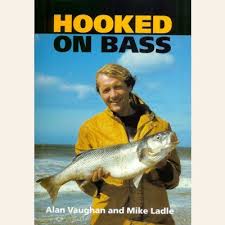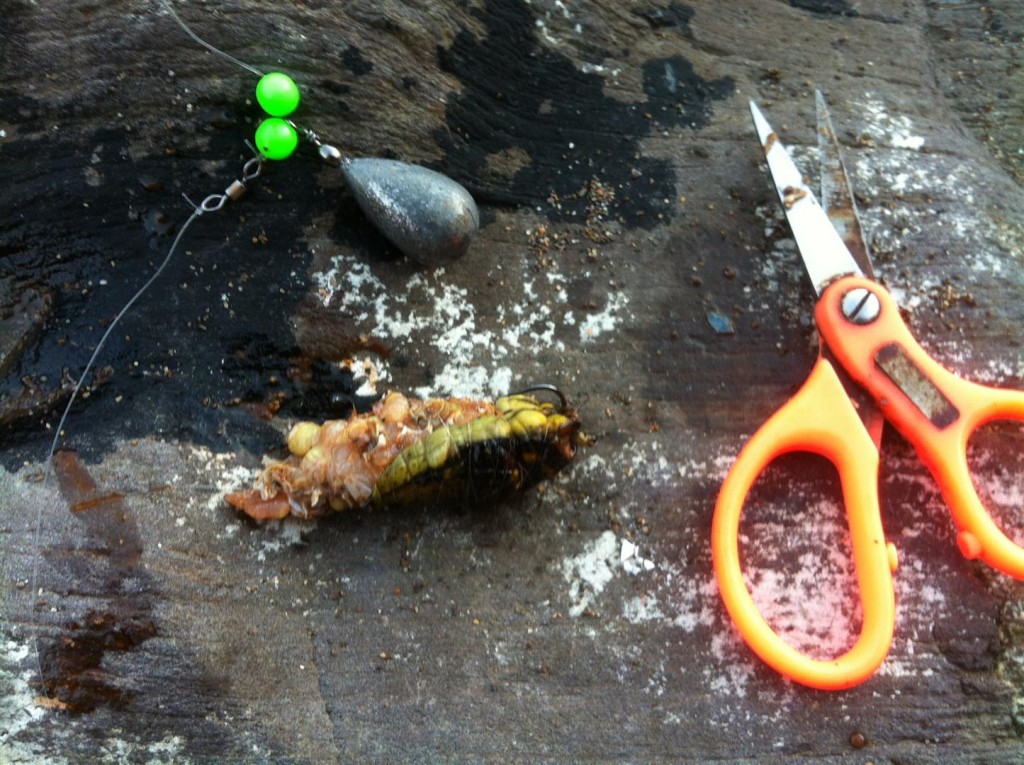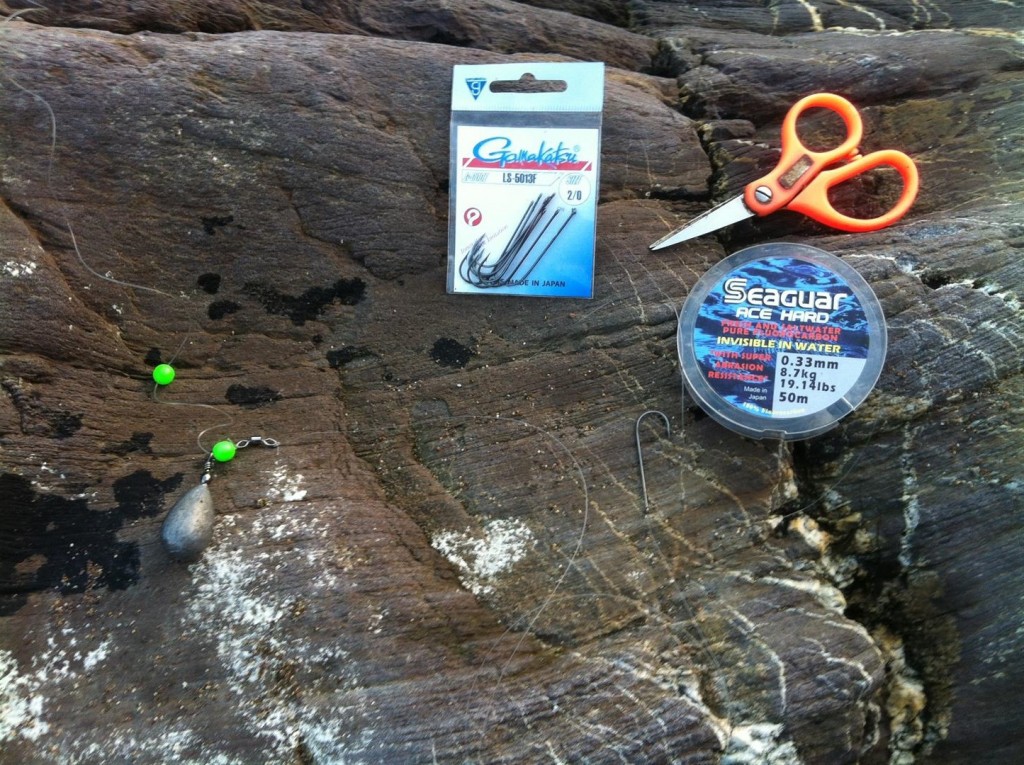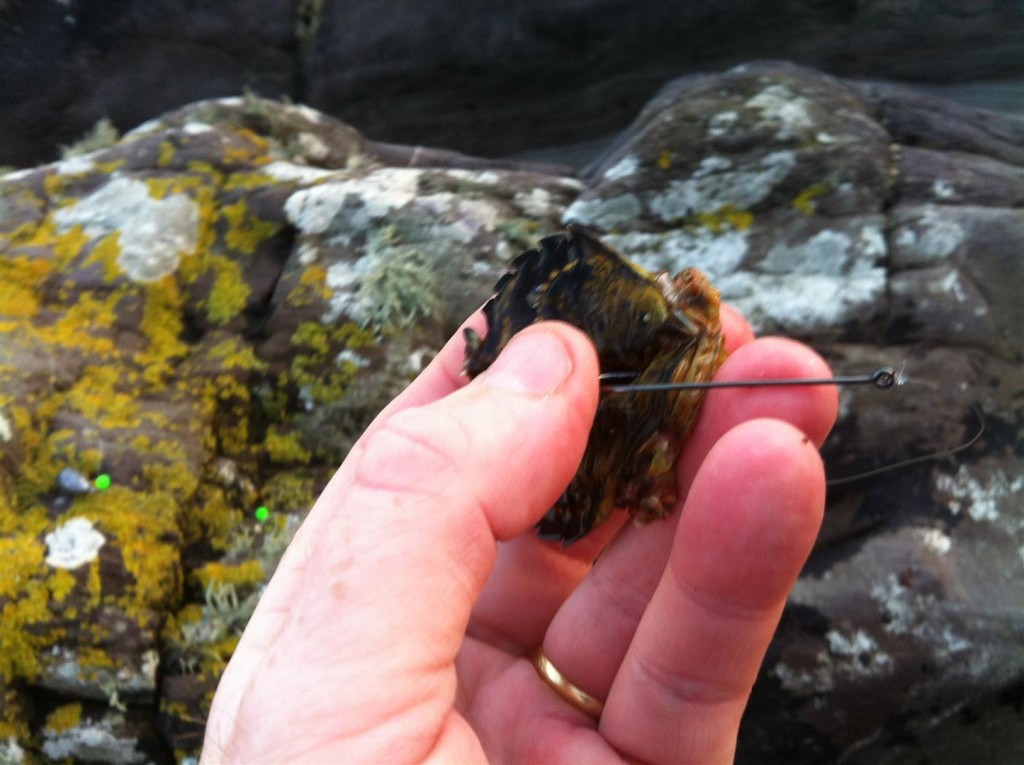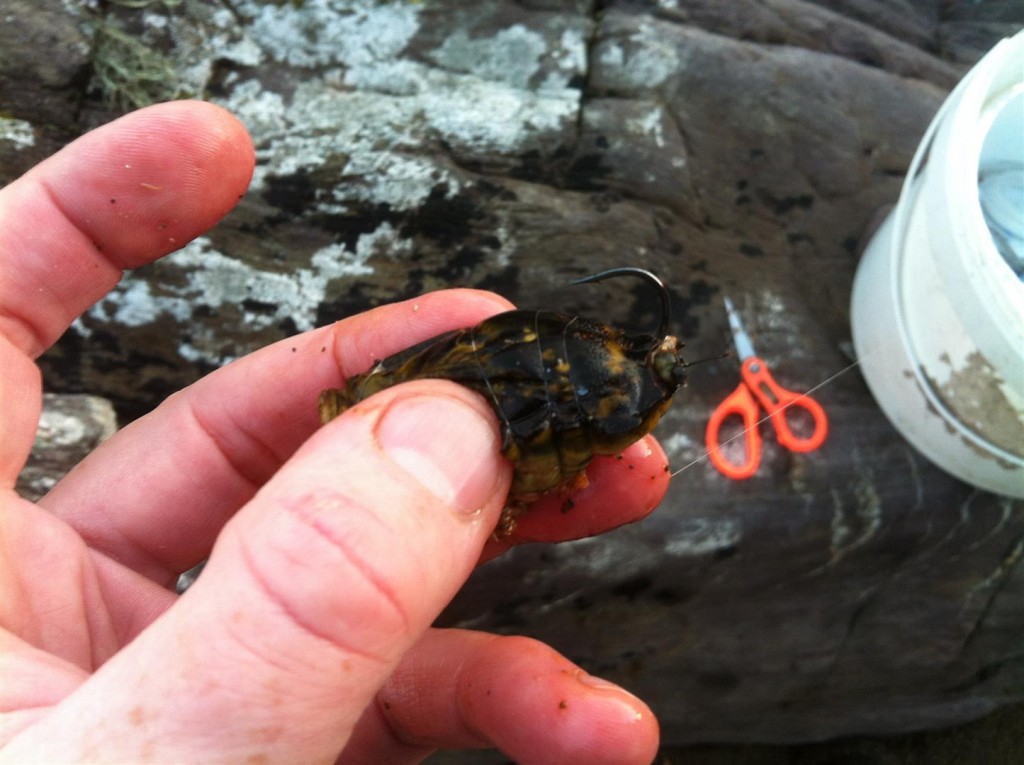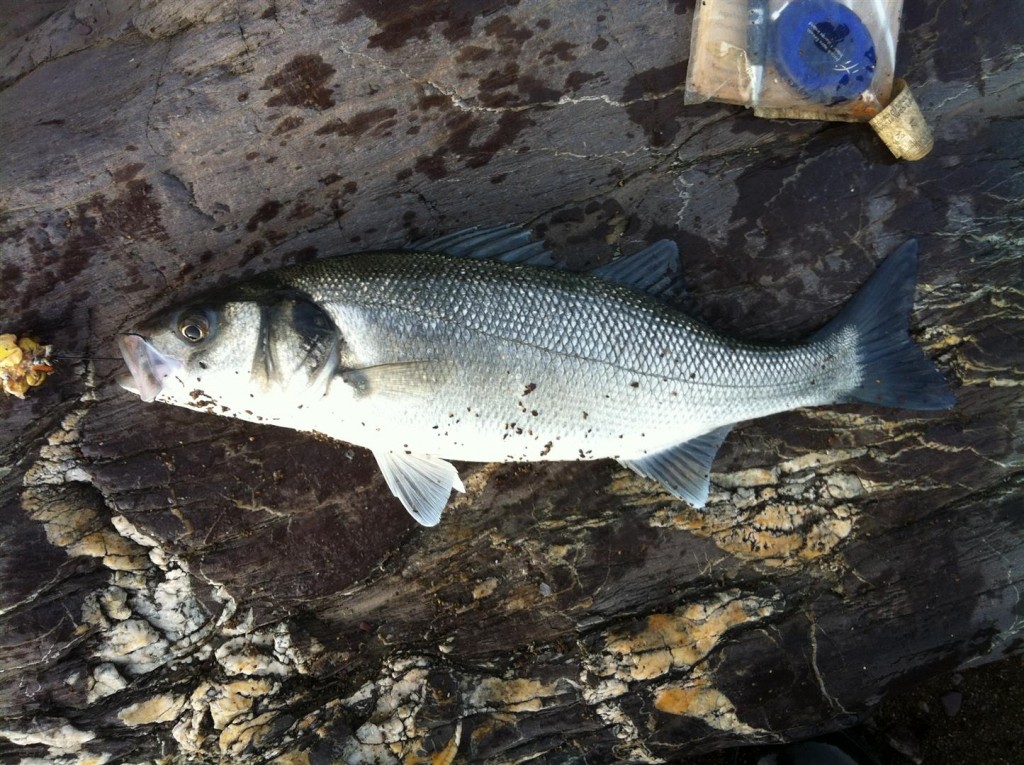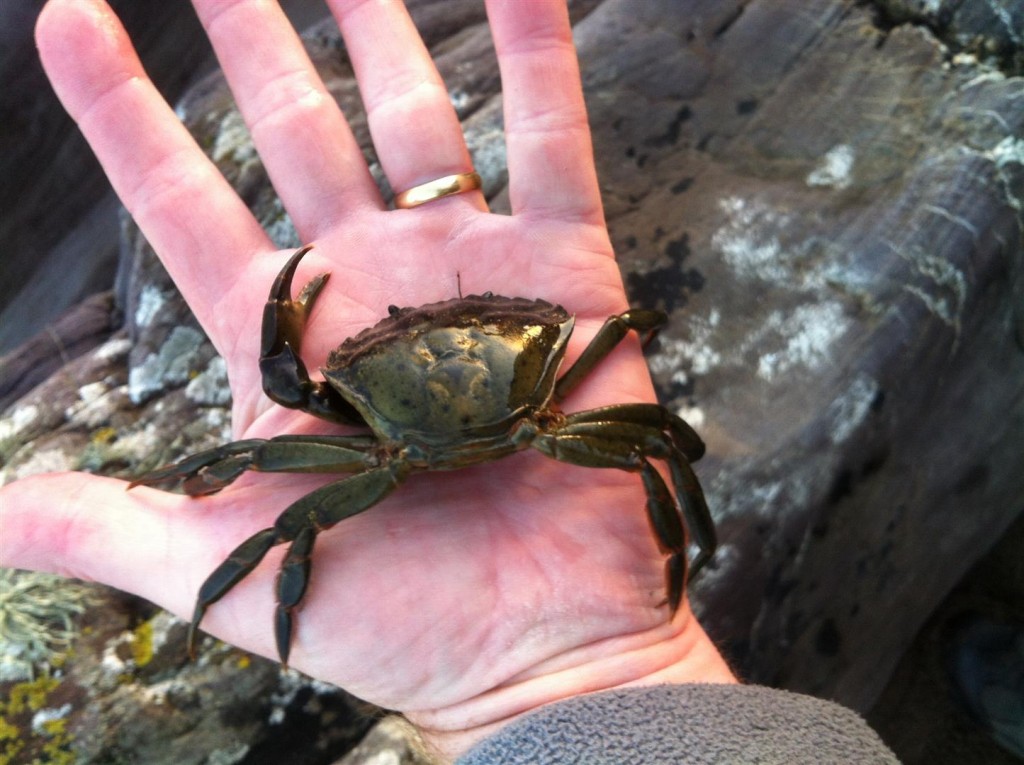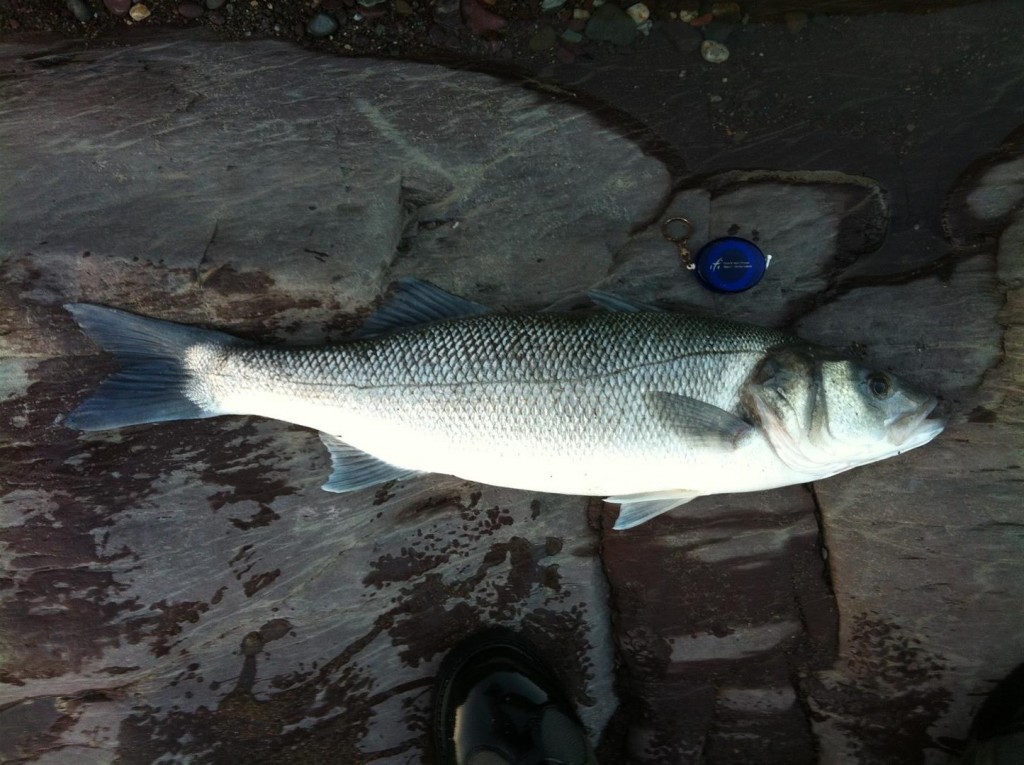The lure of bass is a strong one. Some lure anglers will hang up the gear and wait for spring. Some lure anglers will use light gear and bait. Pat O'Shea gets itchy and needs to scratch that itch!
When it comes to bass my preference has always been to lure fish. However, the vagaries of late autumn and winter weather dictate that back up options should not be discounted or else your number of days fishing may become severely limited. It’s on those days after numerous low pressures have tumbled through that your lure fishing skills are tested to the limit and your patience can run thin. What do you do when there is still a good surf running and the sea has the consistency of a cup of tea? You can stick with lures but it does become a challenge. If you are up for a challenge then stick with it but it does become a bit more miss than hit. I have found bouncing soft plastics slowly along the bottom to be my most successful method under these conditions. In the past I’ve used giant Xlayers in white or pearl matched with 17gm Xorus jigheads with some degree of success but be prepared for losses. I’ve also had some luck with large unweighted slugs and large slug-go’s retrieved at an excruciatingly slow pace so that they flutter and waft with the to and fro of the swell. Under these conditions the trick seems to be to get your lure down deep and keep it there. More often than not, though, I resort to a bit of bait fishing. I do enjoy standing in the surf on a storm beach legering for bass or fishing with crab from a rock mark and it’s under these conditions that I can get back to my roots, as it were, for this is how I got into bass fishing in the first place. If I had a preference it would be for fishing rock marks for at this time of year there is always a chance of a real lunker using this method.
In the early days of my angling career the standard method for fishing rock marks was to float fish. All my senior angling colleagues in those days pointed me in that direction. It was the done thing – A simple enough method of suspending a crab bait under a standard float. Enough weight was added to cock the float and the float was set at depth to ensure that the hooked crab didn’t snag the bottom. I had a modicum of success but was never entirely happy with the method. I certainly didn’t seem to have the success my angling mentors were having. What frustrated me most was in those conditions where waves ‘broke.’ Invariably, the float rig was dragged shoreward and, in many instances, was snagged.
My own eureka moment came when reading Dr. Mike Ladle’s great book ‘Hooked on Bass.’ In it Mike expounds legering as a great and simple method for fishing various types of rock marks. I resolved to give it a go. However, it was many years later before I was to put it into practice. What prompted me was a chance encounter with two Welsh anglers. I came across the two lads while lure fishing a favourite low water mark of mine. One was lure fishing but the other had given up through lack of success and was pottering around the semi-submerged gulleys hunting out edible peeler crabs. I had a brief chat with them and carried on my way. Later in the afternoon I came across the crab hunter again. The tide by now was fully in and the extensive low lying reef was now covered. After an exchange of pleasantries I continued on to my perch, which was close by. I was using plugs that day and worked the area around me but out of the corner of my eye I kept my Welsh friend under close observation. It wasn’t long before he was into a fish. A fine plump 4lber it was too! Shortly after he was into another….and then another….and then another again. Four similar sized fish in less than twenty minutes. I hadn’t even got a knock. I felt grossly inadequate, as you do in these occasions. I had to find out how he was doing it. Sure enough he was employing those same simple tactics recommended in ‘Hooked on Bass’ that I had read about. Big chunky quarters of those edible crabs that he had retrieved earlier were being lobbed out less than thirty yards and they were doing the trick. I resolved to give it a go.
That autumn I had great success and perfected the technique that I was most comfortable with. I have maintained that success in the years since and have found it a great technique to suss out a new mark. I have also found that this style of fishing tends to eke out the bigger fish particularly in autumn and early winter. The best marks are those we wouldn’t have dreamed of float fishing previously. Areas of relatively flat reef interspersed with rock pools and shallow gulleys that are barely covered with a few feet of water at high tide. It’s amazing how close in the bass forage in these spots with barely enough water to cover their backs but these areas abound with life; shrimps, butterfish, gobies, blennies, rockling and, of course, various species of crab.
Rigging
Well what about that simple rig? I keep mine very simple – two or three feet at most made from fluorocarbon or amnesia depending on water conditions. The better the water clarity the more inclined I will be to opt for fluorocarbon. As regards breaking strain I tend to use between 15lb and 23lb but always making sure that it is less than my mainline breaking strain. Losses are inevitable; it goes with the terrain but by keeping trace strength lower the mainline then losses may be limited to only the rig itself. On the business end I used have a preference for Kamasan B940’s in 3/0 but on occasion used Kamasan Uptide hooks from 3/0 upto 5/0, depending on the size of the crab baits. Lately, I’ve started using Gamakatsu in 2/0 and find them excellent. A small swivel on the other end finishes off the rig. On the main line I normally use small bullet leads, either ½ ounce or an ounce in weight, and use a bead between the weight and the swivel. If tougher conditions prevail with a bigger swell or surf I might opt to use a two ounce lead but never any heavier than this. You’d be surprised how quick a crab bait is dropped if any resistance at all is felt.
The Fishing
The takes at times can be quite subtle and that’s why it’s so important to keep your rod in your hands at all times. I distinctly remember one early season session many years ago when the take was so subtle that I was mentally questioning myself whether or not it was a take but instantaneously struck to find myself connected to a superb 9 ½ lb fish. Sometimes, on the other hand, the takes can be quite savage. Recently, I had a take so savage that it caught me completely by surprise. I had only begun my session and was on my first cast. I had three rapid and savage thumps that had my rod doubled over and almost dragged from my hands. I didn’t have time to react, my anti-reverse lever was off, my drag wasn’t set and in an instant the fish was gone. I reeled in to find my swivel still connected but with only three inches of the 19lb trace still attached. What size fish was that? I’ve since been consoling myself that it may have been a good fish of 8lbs or thereabouts and dispelled all notions that it was a double!
….but doubles are a distinct possibility and the old maxim of big baits for big fish certainly holds true for this style of fishing. Baits for me are always crab. Crab, crab and more crab. Although, I have read that mackerel, head and fillet, and squid are just as effective I’ve yet to try them. Instead, I’ve always reverted to crab, mainly peelers but also softies and even crispies. I’ve found that the latter two to be most effective in clearer conditions and have a preference for using them early in the season.
I’ll always use a whole peeler and even two if they’re small. My favourite size is a palm sized one. I’ll fully peel the crab, remove the legs, claws, and lungs and then hook the crab in the rear near the back and out near its mouth. I’ll then bind the crab on tightly with fine elastic thread until it resembles a sausage and ideally is bursting slightly. However, on occasion I’ll use other methods. In settled conditions I often just take the top shell off, keep on the claws and legs, and insert the hook through one of the back leg sockets and out the other rear leg socket. With softies and crispies I’ll also hook in this fashion but push the crab further up the hook shank and bind the legs of one side of the crab to the shank and trace line. In coloured conditions I sometimes split the crab almost in two and weave the two halves up the hook binding on tightly again. Once ready I just lob the bait out. A short cast is all that’s required, no more than thirty yards and shorter at times.
Rod Choices
The rod I use is one of my old favourites, a Daiwa TDPK115, designed by Paul Kerry many moons ago. It’s a specialist bass rod but in essence is a light beachcaster designed to cast between 1oz and 3oz. You could use the same spinning rod you use for lure fishing, and it would certainly be much lighter to hold constantly. However, I like the beachcaster as I can hold the mainline high when there is weed in the water, which there often is after the autumn storms, and continue fishing when otherwise the weed might have dragged my line into shore. I team this up with a medium sized spinning reel in the 6000 to 8000 category. This allows me to retrieve line at pace over the shallow ground and avoid snags. I’ve used Shimanos in the past, such as the Biomaster 7000 XSA or the Navi 6000 XSA, but currently am using a Mitchell Avocast 8000, which is working out fine. I used to fill these with Sufix Tritanium 25lb bs mono straight through but I’m now using braid for its better bite detection. It’s essential to use a leader with this, though, as the braid will not stand up to any abrasion. I’m using about 12 feet of 0.5 Tubertini Gorilla UC4 Fluorocarbon at the moment and I find it excellent.
When I started rock fishing this way I used to fish when the sea state was relatively settled. As my confidence grew with the method I tried in more testing conditions each time. I’ve found that a sea state with swells of 2.0 meters about the maximum that you can successfully fish this way. You may not be able to fish your mark the day after a gale but by the second day after the swell height may have dropped to this level. Be careful, though, rock marks can be dangerous under these conditions. Its best to fish the shallow reef marks as the waves break well out and you won’t be as easily caught by surprise as you would with those rock marks with a bit of depth in front of them. However, it’s often under these testing conditions that the better fish can sometimes be caught. A recent outing proved that to me once more.
A number of weeks back a storm passed through the south coast on a Thursday. By the following day the weather had settled down a bit but there was still a lot of rain. By the Saturday it was more settled again and the wind had swung around to the North West quadrant. Once the breeze swings offshore conditions settle down quite quickly. It was my cue and off I headed in full anticipation. When I walked from the car to my mark I could see that there was quite a big swell. Readings from the weather buoy later confirmed the swell height at 1.8 metres. The waves were breaking three sets out from the shore and the water was coloured being a grey-green tinge with a sandy colouration in places. My target area, thirty yards out, was a maelstrom of white water. I set up a three foot leger with a fine juicy crab on a 2/0 Gamakatsu hook and cast out. Straight away I could feel a bit of weed hitting the line and after a while the waves began to pull the light bullet lead in. I changed over to a 2oz bomb lead and this held much better. It was still coming in a bit but, at least, I was fishing. I clambered onto a large rock on the high water mark. Some of the waves were starting to come over this. Conditions were at the limit of fishable. Then, I felt a few gentle taps. I struck immediately and was into a fish. This was a good fish. It fought vigorously and used the strong undertow to full effect. After what seemed an age I had it nearly coaxed into my perch. I could see that it was a really good fish. It was a fat bugger as well! When landed it measured 76cm in length and 44cm in girth. On the scales it weighed 10lb 2oz. A fine specimen! After taking scale samples for the Inland Fisheries Bass Scale Programme I revived the big girl in a rock pool. It took some time but the fish finally did swam off into the turmoil quite strongly. Not all sessions are this successful but it sure was a ‘Carlsberg’ moment. (Ed: “By God I’m sure it was!”)
Recently, I was reviewing some old Irish Specimen Fish Reports. Many of the bigger bass of yesteryear were caught on crab and knowing some of the characters named I couldn’t help but reflect that these fish were more than likely caught on rock marks. These days you just don’t see people rock fishing with bait. I certainly haven’t come across any anglers doing so since I met those Welsh lads all those years ago. In an age where lure fishing predominates, there are other ways to skin a cat (or bass) and at this time of year conditions may dictate that it may be your best option. Give it a go, you might be pleasantly surprised with your results.



